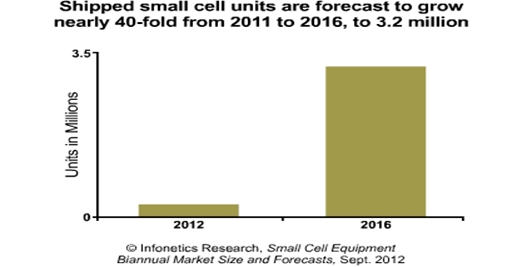カリフォルニア州・キャンベラ、2012年9月27日-市場調査会社Infonetics ResearchはSmall Cell Equipmentの市場規模と予測に関する最新レポートを発表した。レポートでは、microcells、picocells、femtocells(公共スペース、非住居区)、そしてSmall Cellを製造するベンダーをカバーしている。

アナリストノート
「ユニット数という観点からすれば、Small Cell市場は大きいかもしれないが、喜ぶのはまだ早い。まだまだ解決しなければならない深刻な問題が山積みで、中には解決出来ないような問題もある。」とInfonetics Researchで携帯インフラと通信エコノミクス分析を担当している主席アナリストStephane Teralはコメントしている。
またTeral は次のようにも述べている。「あるオペレータが何千台ものSmall Cellを持っているとしよう。それらすべてをどう管理するのか?バックホールはどうするのか?事業者と話をする際、バックホールは常に最大の問題だという話になる。さらにもちろん干渉の問題もしっかり管理しなければならない。勘違いしないで欲しいが、Small Cell市場は間違いなく存在し、そして急速に成長をしてはいる。しかしそのボリュームはSmall Cell市場に参入しようとしている多くの事業者をサポートするには不十分なのだ。Small Cellに"エルドラド(宝の山)"はない。ベンダー間の激しい競争が立ちはだかり、誰もが勝てるような市場ではない。」
レポートの共同著者であり、Infoneticsの無線&モバイルオフロードを担当しているRichard Webbの追加コメント。「公共スペースでのfemtocellは世界中で出荷されているSmall Cellの70%以上を占めるまでになっている。都市部の公共スペースでfemtocellを採用することで、モバイルオペレータはデータオフロードの問題に対応することが出来る。オペレータがLTE femtocellを利用し、LTEマクロ基地のエリアやキャパシティを補強すれば、4G femtocellセグメントは飛躍し、2014年までにはSmall Cell市場の主力成長エンジンとなるであろう。当面の間はオフロードに関しては、セルラーベースのSmall Cellと比べ、簡単に採用出来るキャリアWiFiの方がより早いペースで伸びて行くだろう。」
SMALL CELL市場のハイライト
- 3G microcells、4G mini eNodeBs、femtocellsの3G及び4Gパブリックアクセスを含むSmall Cellユニットの販売数は2011年から2016年にかけて40倍近く成長すると予測されている。
- Infoneticsは世界的なSmall Cell市場の売り上げは2011年から2016年にかけての5年間、年平均成長率(CAGR)73%で成長していくとみている。
- アジア太平洋地域はSmall Cell市場で最大の規模を占めており、少なくとも2016年まではこの状況が続くと見られる。
- Small Cell採用に影響を及ぼす問題は地域ごとに異なるが、バックホールリンクの品質、価格、セル間干渉、周波数の空き状況や規制などの問題がある。
Infonetics' biannual Small Cell Equipment report provides worldwide and regional market size, forecasts, analysis, and trends for 3G microcells, picocells, and public access femtocells and 4G mini eNodeB (LTE) and public access femtocells (LTE). Vendors whose small cell solutions are tracked in the report include Airvana, Airwalk, Alcatel-Lucent, BelAir, Cisco, Ericsson, Huawei, ip.access, Motorola, NEC, Nokia Siemens Networks, Samsung, Ubiquisys, ZTE, and others.
(原文)
Small cell market not big enough for all who want to play in it
Campbell, CALIFORNIA, September 27, 2012-Market research firm Infonetics Research today released excerpts from its latest Small Cell Equipment market size and forecast report, which tracks microcells, picocells, and public access femtocells and the vendors who manufacture them.
ANALYST NOTE
"In terms of units, yes, small cell numbers can be big, but don't get too excited - there are a lot of serious issues that need to be resolved, and some that cannot be resolved," cautions notes Stephane Teral, principal analyst for mobile infrastructure and carrier economics at Infonetics Research.
Teral adds: "Let's say an operator has thousands of small cells; how do you manage them all? How do you backhaul them? When we talk to carriers, backhaul is always the biggest issue. And then of course they have to get interference under control. Don't get me wrong; there is no question that a small cell market exists and it is growing fast. But the volumes will not be high enough to support the number of vendors trying to get into the small cell space. There is no 'El Dorado' in small cells. A vendor battle is looming and not everyone is going to win."
Co-author of the report, Richard Webb, directing analyst for microwave and mobile offload at Infonetics, adds: "Public access femtocells already make up more than 70% of all small cells shipped worldwide. Deploying femtocells in public metro spaces could help mobile operators address the data offload challenge. As operators utilize LTE femtocells to complement coverage and capacity for LTE macro deployment, the 4G femtocell segment will take off, becoming the main growth engine of the small cell market by 2014. In the meantime, carrier WiFi will be a faster-growing solution for offload, as it is often less complex to deploy compared to cellular-based small cells."
POLICY MANAGEMENT MARKET HIGHLIGHTS
- The number of small cell units sold is forecast to grow nearly 40-fold from 2011 to 2016, including 3G microcells and picocells, 4G mini eNodeBs, and 3G and 4G public access femtocells
- Infonetics expects global small cell revenue to grow at a 73% compound annual growth rate (CAGR) during the 5 years from 2011 to 2016
- Asia Pacific dominates the small cell market and will continue to do so through at least 2016
- Issues affecting small cell deployment vary from region to region and include backhaul link quality and affordability, inter-cell interference, spectrum availability, and regulatory restrictions

